CIVIL SOCIETY
The garden in Cape Town where the possibility of individual and social change grows
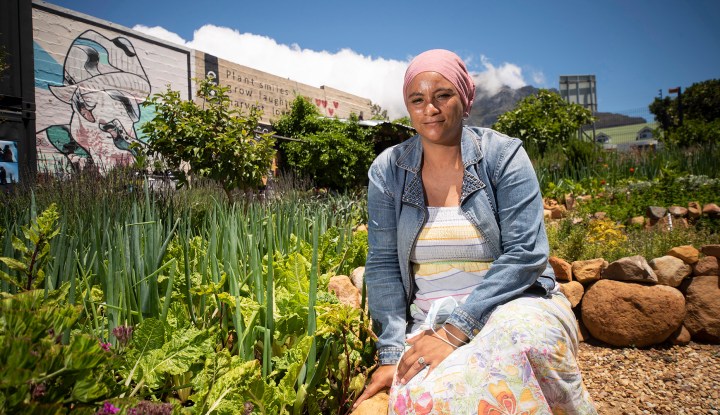
Two years ago, Devil’s Peak and Vredehoek, two adjacent suburbs in Cape Town’s City Bowl, were as socially fractured as the rest of South Africa, but a unique approach is turning people who live in formal housing and those who live on the streets into proper neighbours. And everyone is winning.
It’s just after eight on a Tuesday morning and, despite the blustery summer wind noisily shaking the trees, there’s already a peaceful bustling in the garden opposite the petrol station and the Jehovah’s Witness Kingdom Hall in Upper Buitenkant Street.
“Ooh, uh-uh. Ek like nie die wind nie,” says one of the gardeners in greeting as she tucks a tiny lock of hair back into her tight ponytail. She is wearing a blue T-shirt with “Streetscapes” printed in white across it.
In the furthest corner of the garden, a few people wearing the same T-shirt are sitting on a bench waiting for Chantel Sampson. It’s the cleaning team, separate from the people moving among the lush beds of kale, onion, spinach and cabbage, weeding, turning compost, watering or forking over the soil.
What was once an unused, fenced-off piece of city land where council workers occasionally came with their weed eaters to mow down the knee-length grass, is now a public open space with a succulent garden at the entrance, rows upon rows of vegetables planted in a circular, maze-like pattern in the centre, huts for gardening business, water tanks and a compost toilet for the workers.
All of it – down to the very last stone, strut, bench and seed – was moved into place by people who do not live in any of the houses or flats in the area, but who live on the streets.
Sampson arrives, greets people, passes on information, and gives instructions for the day’s work. There’s to be a Streetscapes Christmas party in the garden the next day, so the cleaning team is going to be cutting the longish, meadow-like grass on the fringes.
“Jesse’s trying to get us a weed eater, but use the clippers for now,” Sampson says. One of her team members, a short, bearded man, tells her that he’s worked with a weed eater before. He offers to do the work when the machine arrives.
Basics sorted, Sampson retreats to a bench in the shade. She is wearing a pink doek, a thin cotton floral dress in anticipation of the day’s heat, and sandals. Her pedicure, a deep plum, gleams fresh in a pretty pair of sandals. Her freckled face, like her demeanour, is open and friendly. She speaks without guile. Candidly and confidently.
There is nothing in her appearance or her behaviour that would make you suspect she is fresh off a substance addiction and a five-year stint of sleeping rough. She looks like any working mother – cheerfully busy and unquestionably competent.
One cannot imagine a person more suited to the work they do than she is. Nor anyone more symbolic of the possibility of individual and social change.
Sampson is a trained peer counsellor for Streetscapes, a Khulisa Social Solutions project that runs three city gardens and a farm in Kuilsriver, employing people who live on the streets, but her salary is also partially paid by the residents of the two suburbs where her work is concentrated.
She walks around Devil’s Peak and Vredehoek every day talking to people who live on the streets – whose numbers have increased enormously since Covid – finding out what they need and pointing them towards services offered by the city and the various organisations working with the unhoused in Cape Town.
Over the past two weeks, however, her remit has broadened. Due to some funding from the city, Streetscapes has been able to employ more people off the streets, 12 of whom now make up Sampson’s cleaning team, and she has an assistant, Sibongile Lituka. The team, in Streetscapes bibs, is eating breakfast by the hut in the garden’s furthest corner. They’ve met here daily for two weeks now and, after a morning snack, they head into the steep streets of the suburbs they serve, carrying bags, rakes and brooms.
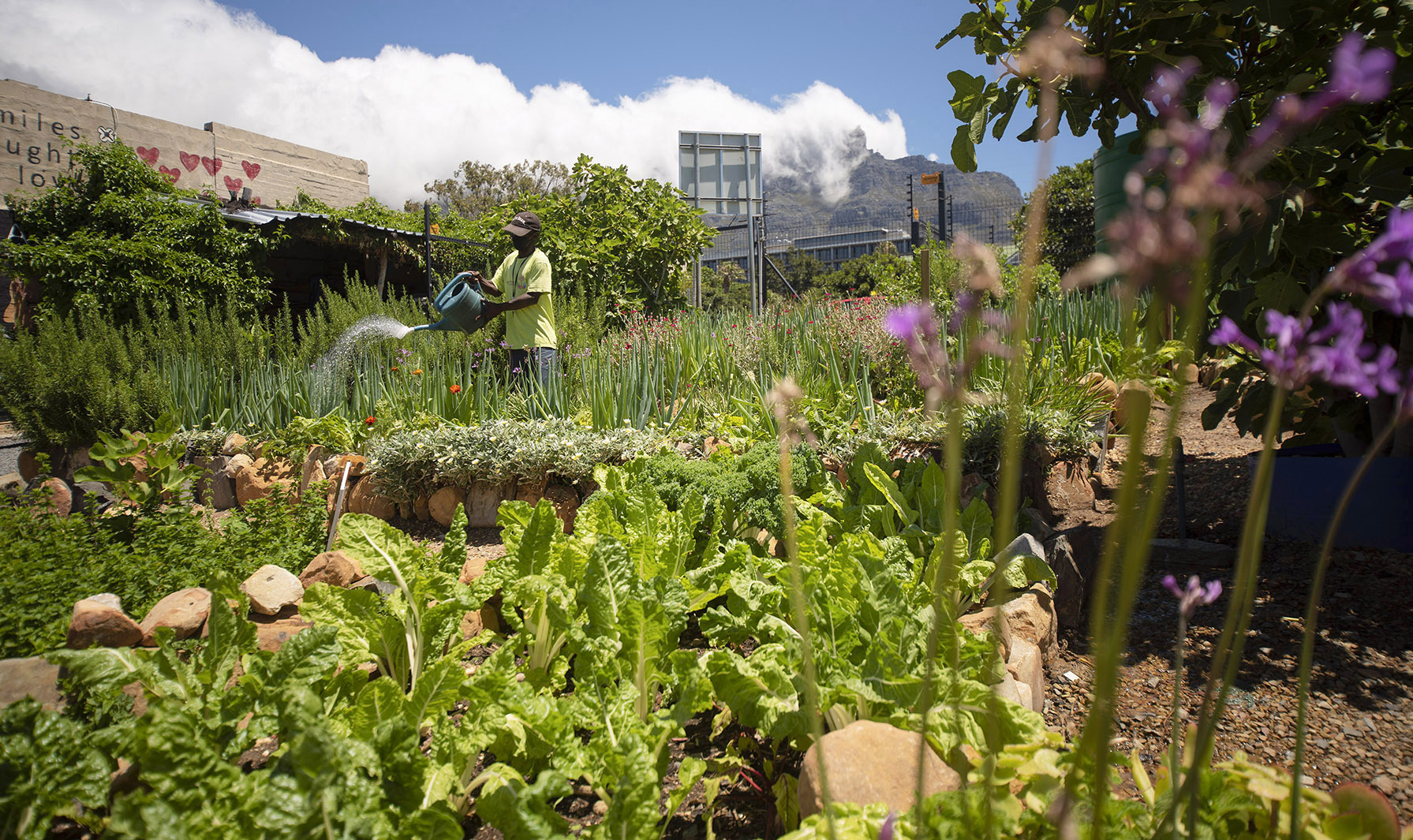
The Streetscapes city gardens got off to struggling starts in the wake of the drought, but are flourishing now. (Photo: David Harrison)
“The residents love them,” says Sampson. “People shout or hoot or wave or give us a thumbs up when they drive or walk past. They stop and chat. Residents bring us water or food. Once, when I was still working in the garden, someone brought us each chicken and chips in our own box.”
The garden has changed the neighbourhood in many ways. It provides fresh vegetables, not only for people who can afford to buy them cheaply, but for others too. Residents from the surrounding flats bring their organic waste to feed the enormous compost heap, which in turn feeds the garden and reduces landfill toxicity.
The garden was started in 2019, at the tail end of the devastating drought, and had no water. Residents brought grey water to fill a tank that had been set up near the fence and could be accessed at any time of day. The city has since connected water, but it was grey water that turned the dry, patchy land with its struggling seedlings into the oasis it is just three years on. The goodwill, the urge to make the garden work, was palpable on the neighbourhood Facebook group from the very beginning.
Environmental and produce benefits aside, the garden has, possibly most importantly, given many people a reason to get up in the mornings.
“Having this job,” Sampson says, “It gives you something. It changes your mindset.”
She had been living in a tent in a park near the mountain at the beginning of 2020 when she first decided to take up an offer to work for Streetscapes. She worked only on Tuesdays, earning R100 a day.
“Take me, for instance. For the first month, I worked in the garden. I was still using. The money I earned went to drugs. But the second month, I realised I could have bought myself a pair of shoes with that money. So, the next time I bought shoes. Then I bought my own toiletries. I didn’t have to take them out of the bins any more. I thought, if I earn money, I don’t have to skarrel all the time for everything.
“Also, if you work here for six hours a day, that’s six hours you aren’t using. And if you’re not working, you just lie there where you sleep all day. There’s nothing to get up for. There’s nothing to do.
“But these guys,” she says, waving towards the cleaning crew that has begun to tidy up under the trees, by the benches and the wire art done by the homeless, “since they started here two weeks ago, they are here every single morning before I even get here.”
Sampson is living at the YMCA in Observatory now. She is married to a wonderful man. Next week, her oldest daughter is getting married and her intense joy at being able to contribute financially to the event is evident. She worked in retail before she ended up on the streets where, she says, “no normal person who lost their home can survive without drugs or alcohol”. But working as a peer counsellor seems to have pointed her face towards the sun of her life’s meaning.
“I love it. I can help the next person, you know. Some of the people I work with now used to be my friends from before. For them to see me where I am – it gives them hope. And they are happy for me.”
Next year, with money raised by the DPV Outreach from the residents of Devil’s Peak and Vredehoek, Sampson will start her studies to become an auxiliary social worker.

The garden on the corner of Upper Buitenkant and Rugley Road has improved the lives of all the people who live in the area, whether they are housed or unhoused. (Photo: David Harrison)
A crack in humanity
Jesse Laitinen describes her title as managing director of Streetscapes.
“But that sounds very fancy. I’ve dug holes. I’ve been the social worker. I’m the administrator. The fundraiser. The ops manager.”
Laitinen started Streetscapes in 2015 with a social worker and thirty homeless people. She recently overheard someone exclaim how embarrassed they were about the destitute people camped on their street when they had dinner parties.
“That kind of thing flabbergasts me. I just cannot understand how entitled people can feel: that it’s an issue for your dinner party, and not that there’s a real human being living on that pavement.
“That disconnect – I find it hard to deal with. And also, when you work with people for a long time, anywhere, you like them. I like the people I work with. Some of my closest friends are people who have come through the programme, and you can’t help but take it a little personally sometimes, because they are talking about your friends in such a dehumanising way.
“I don’t think those people are evil, but I do think that we have a huge disconnect. This kind of othering… I don’t know if it’s the apartheid past where people just conveniently boxed people into ‘our needs’ and ‘their needs’, but there’s this crack in humanity that troubles me deeply.”
But what’s happening in Devil’s Peak and Vredehoek – the genuine, creative, fluid, ongoing, determined work to serve the needs of the housed and the unhoused as one community – has given Laitinen hope.
“It’s unique, what’s going on there. We’ve done much more work with DPV, both the Watch and the Outreach, than we’ve done in any other area, and it speaks of an exceptional level of commitment and motivation from the side of the Outreach team. This is not a negative comment about the other areas we work with, but it’s just really exceptional for people who have other jobs and busy lives to get so involved.
“It makes our work so much easier. There is only so much one NGO can do. We have our internal work with our clients and case management, but we also must work with the system, shifting how government practice and policy works, and a lot of that is linked to what businesses and residents say. So, we work with government and we set up pilots and we find individuals who are more progressive and open-minded and push for ways to do things within the systems, but often it’s the businesses and residents politicians listen to because those are your voters. So, if you start affecting public awareness and attitude, that’s where you change the system as well.
“That’s why DPV Outreach is so important because they speak to the other residents and to their neighbours and the exposure and evidence and the ideas and passion spark other fires.
“We know from research around the world that exposure changes attitudes. Because DPV Outreach has always been so keen to collaborate with us, they’ve been exposed to conversations and to people on the streets, and I think that has automatically translated into changed attitudes. And as you feel more for the people you meet, and you see the capacity and potential that lies there, and you like the people, I think that makes you more determined to have more projects.”
The DPV Outreach’s work has smoothed the way for Streetscapes, Laitinen says, because residents “speak the same language”. They understand their neighbours’ concerns about public safety and cleanliness, their fears and biases. Their “reaching out” has not only been to people in need of social support, but also to people who rent and own their homes in the area.
What the DPV Outreach has done is to build a bridge across what often feels like an unbreachable abyss.
Sampson is one of the Streetscapes clients who has come through the Khulisa Streetscapes programme, which focuses its resources on “chronic homelessness, combined with substance misuse and mental health issues”. Streetscapes offers long-term, community-based rehabilitation that combines housing, work and psychosocial support.
According to the organisation’s most recent annual report, 69 homeless people with severe substance abuse disorders took part in the programme in 2020. After a year into the 18-month project, 19% of those have moved into sustained livelihoods (jobs, Sassa grants, or back home to family). Three percent of them have moved to other programmes and remain off the street and only 14% have dropped out and are back on the streets. The rest remain in the programme.
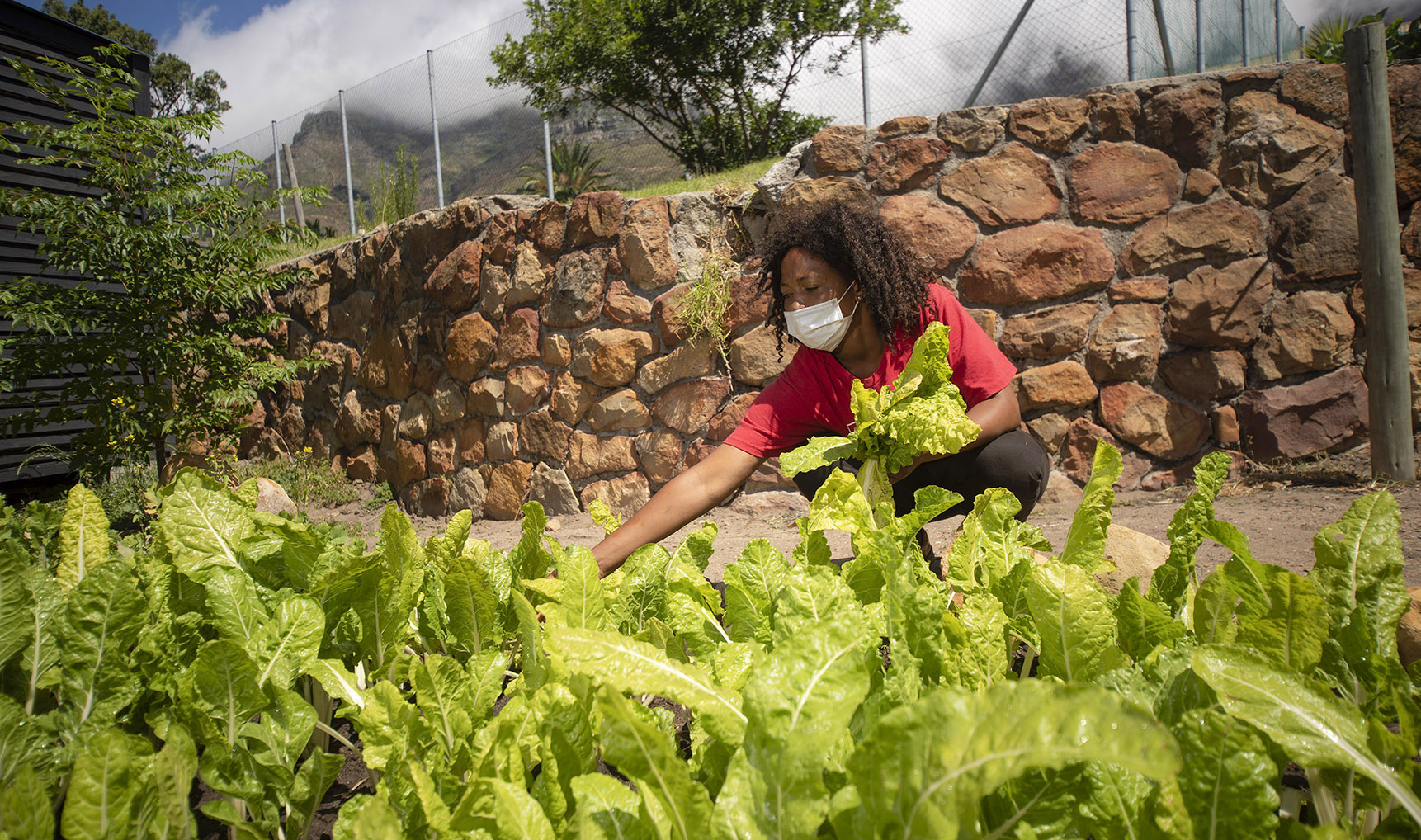
Residents that live around the garden regularly buy their fresh fruit and vegetables from the garden at prices below those in the shops at the shopping centre down the road. (Photo: David Harrison)
The connectors
Community Action Networks (CANs) sprung up all over Cape Town at the beginning of lockdown. These were links between richer and poorer areas, connecting the haves with the have-nots in ways that had never been seen before.
The Devil’s Peak and Vredehoek CAN jumped into almost instant action. It was independent of the well-established DPV Watch, but used its networks for communication with residents, via Jo-Anne Friedlander, who’d long served on the DPV Watch. Food, money, requests, favours, help, support were shuttled between the suburbs right by the mountain and the city’s flatter fringes where most of the poor people live.
As things started to open up towards the end of 2020, and the CAN’s work became less urgent, talk of how to continue the energetic and important work began. The DPV Outreach was formed. It is currently run by six women.
Friedlander, a freelance designer with many years’ experience on the executive committee of the DPV Watch, has found herself in the position of being the Outreach’s main go-to person, but is adamant that she doesn’t want it to seem like “my show”.
“We all do everything. We all work equally hard.”
All the women who work for the Outreach live in formal housing in the area. They have full-time employment, and some have young families too, yet they voluntarily give between an hour and 10 every week towards their Outreach work.
Their mission is threefold: to create an ecologically sustainable community, to facilitate “support for an understanding of people experiencing homelessness and ensuring that they are treated in a holistic way”, and to foster cooperation between everyone who lives and works in the area – including the city, businesses and NGOs.
Friedlander had been closely involved with the tortuous, conflict-ridden, painful and seemingly intractable problem of the rambling settlement of the homeless in Van Riebeeck Park, a lush green lung that lies in Vredehoek’s neighbouring, and more prosperous, suburb of Oranjezicht.
People in the surrounding houses were beside themselves. The noise, the smoke, the mess and the unsanitary conditions of tens of people camped along one of the streams that trickles down the mountain towards the bay had become a daily worry. During lockdown, the camp Sampson had lived in until last year burgeoned exponentially. The cheek-by-jowl proximity of South Africa’s immense economic divides became more intimate, more visible, than anything the city had seen before.
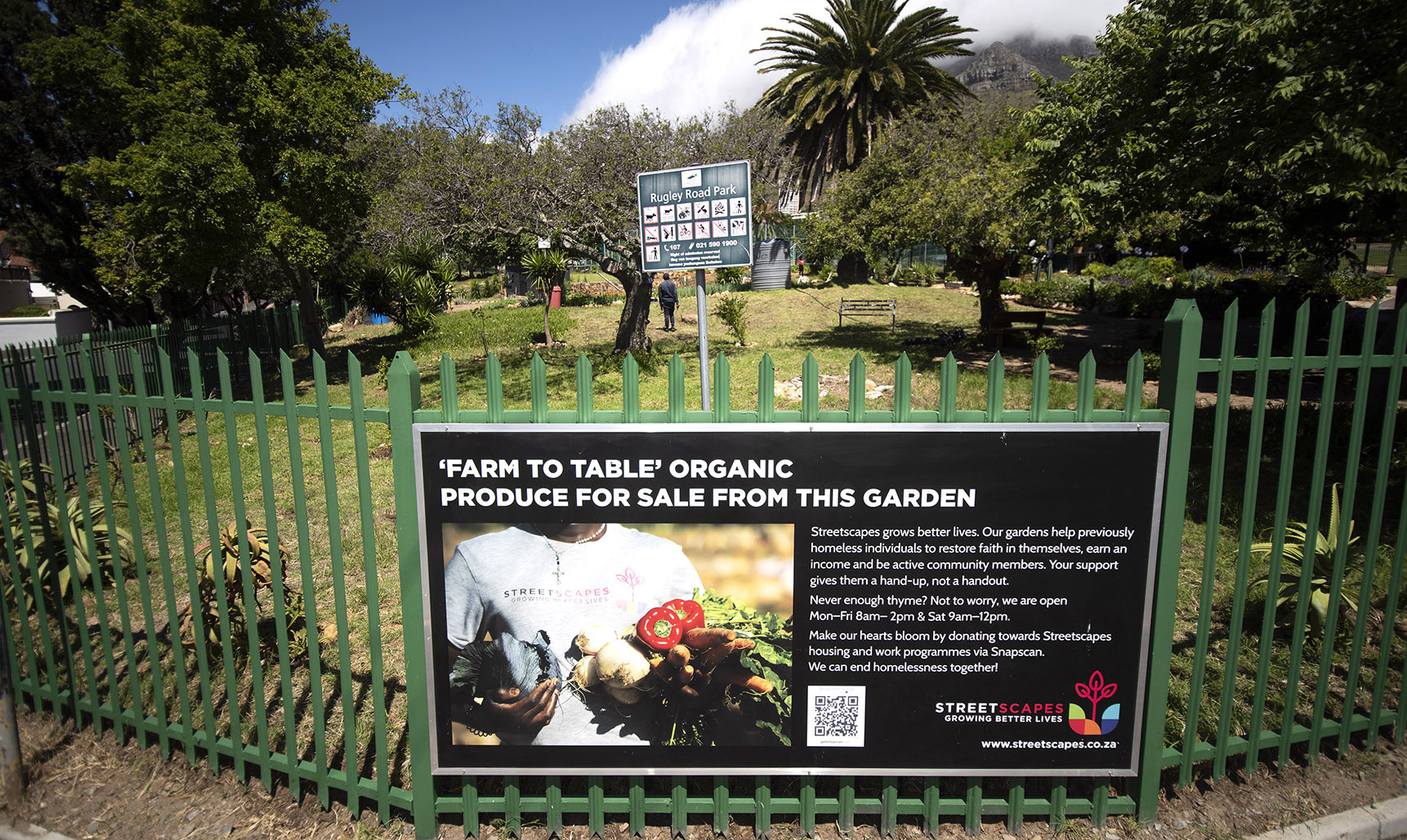
A once-fallow piece of city property, fenced off to prevent rough sleepers from camping down, is now a garden where those without homes can work – or even join in yoga and meditation classes once a week. (Photo: David Harrison)
In desperation, residents decided to raise money to fence off the vast park to prevent more people from settling there.
“And that’s when I thought, I can’t. I just can’t,” Friedlander said. “To think of the hundreds of thousands of rands that would be spent on a fence when it could be put towards improving people’s lives… I just felt I could not be a part of such a choice.”
The Van Riebeeck Park conflict was solved in a different way. There is no fence, nor are there any homeless people in the park now. But that’s a different story for a different day.
Friedlander and the administrators of the DPV CAN, who’d been in contact with one another, formed the DPV Outreach. Together, they raised money for Sampson’s salary, and they will be sponsoring her auxiliary social work studies next year. Fundraising is ongoing, and residents either donate when and how they can, or they set up debit orders of whatever they can afford to spare in their budget and pay monthly.
“Until I started talking to the people who live on the streets, I don’t think I really understood things. They’re quite ordinary people with ordinary needs. Many of the new people who came into the [Van Riebeeck] park had been employed until lockdown. There was a carpenter living there. A forklift operator. A domestic worker. Ordinary people.
“We all know all the problems of life in South Africa. We know the poverty and the struggles all around us. We all have to do something. This is what I do, trying to connect the housed with the unhoused and make the area a proper community for everyone who lives here. It happened quite by accident, in a way, but I like it. And I’m certainly not doing it on my own. The committee is so dedicated and the residents have mostly been very supportive, because they can see the changes in the area.”
Devil’s Peak and Vredehoek is cleaner and tidier than it’s been in years, thanks to the work of the Streetscapes employees. Pavement weeding, sweeping, park clean-ups – the residents are noticing. And they approve.
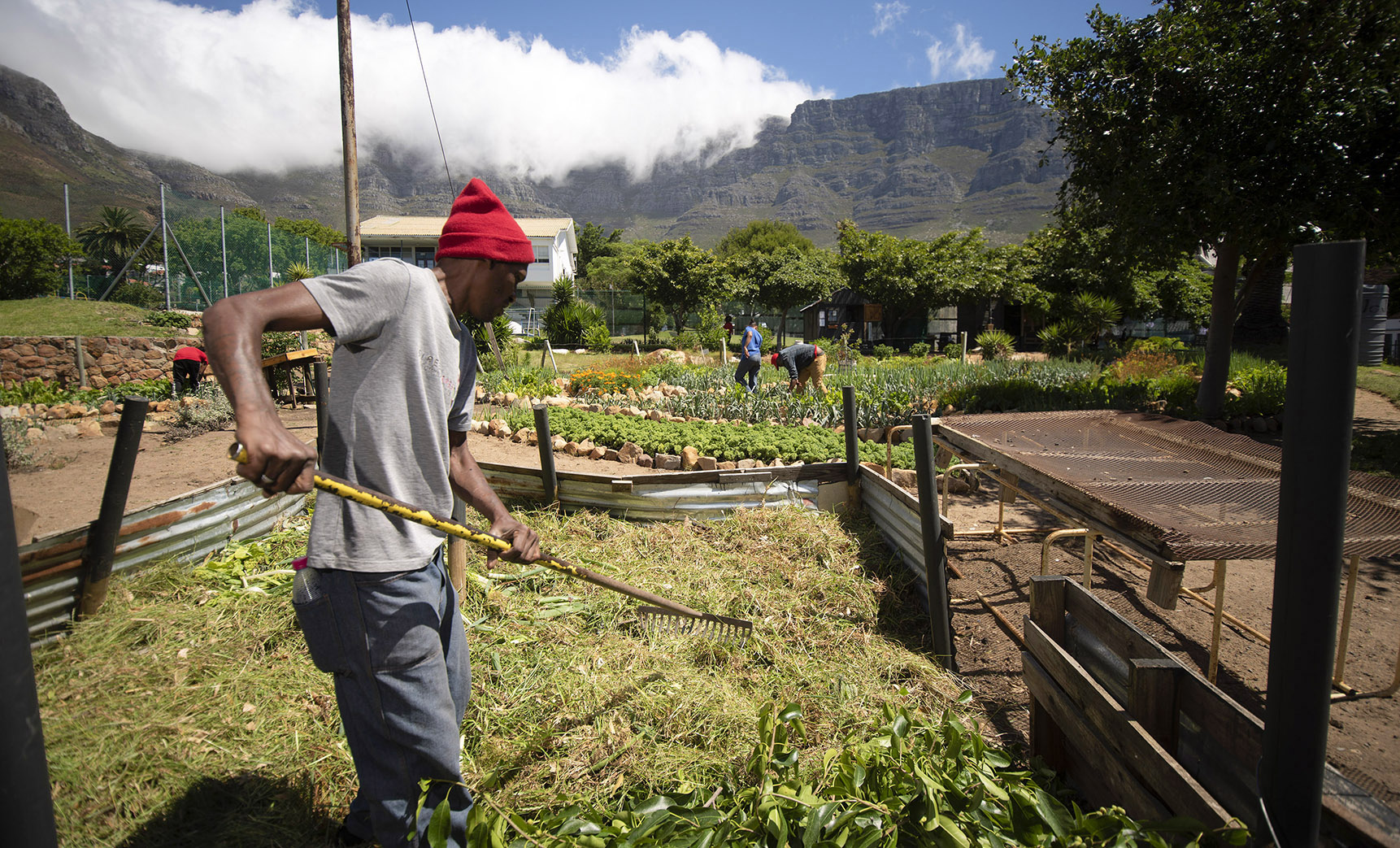
The compost heap is fed from grass clippings and the organic waste provided by the residents of flats and houses that surround the park. (Photo: David Harrison)
Meeting halfway
Sampson offers the people on the street information about where to get help, listens to their problems and offers them work at the Streetscapes gardens, and all the benefits that come with that.
“We are client-driven. We can only meet people halfway. It’s entirely up to them if they want to make a change.”
Sampson calls the people on the street she works with “clients”. She is called a “peer counsellor”, and a “facilitator”. She earns a salary and has a proper roof over her head. She can do the work she does with the homeless because they trust her, and she can work with the residents because they trust her.
Chantel Sampson feels like a hinge on a door that connects the outside with the inside and inside with the outside.
She is a symbol of South African possibility that always feels slightly out of reach. Of something approximating hope. Something tender and ineffable. DM168
This story first appeared in our weekly Daily Maverick 168 newspaper which is available for R25 at Pick n Pay, Exclusive Books and airport bookstores. For your nearest stockist, please click here.










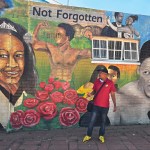










 Become an Insider
Become an Insider
Congratulations to the author for piecing together a genuinely heartwarming story, (accompanied by delightful pictures) at a time when the world seem to heading in other direction.